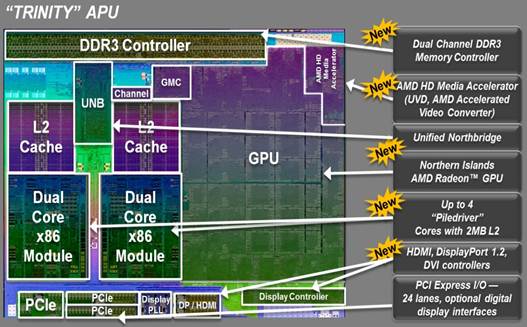Feeling The Heat?
AMD’s last generation of APUs fell behind
when it came to power consumption, and the move to Piledriver has addressed some
of these issues. The A10-5800K’s 30W idle draw isn’t much different from the
31W draw of last year’s A8-3870K or the 33W draw of the Core i3-3240, but the
peak power draw of 131W is reduced from the 150W we recorded from last year’s
top APU, even if it can’t match the 87W top draw of the Core i3.
The A8-5600K isn’t much different, with
idle and peak power levels of 27W and 126W. We’re pleased to see that neither
chip gets too hot: the A8-5600K served up a top temperature of 57X, with the
A10-5800K coming in three degrees hotter. They’re similar figures to the Core
i3 parts, and they’re nothing to worry about. Even AMD’s stock cooler will
easily be able to cope, and there’s enough headroom to cope with the extra heat
generated by overclocking.

Trinity
APU
Pricing
AMD has set out to take down Intel’s Core
i3 with its latest Trinity chips, and that means pricing is extremely
competitive. The two A10-branded chips, the 5800K and 5700, come in at $160,
and the A8-5600K and A8-5500K tip the scales at $128 each.
The weakest chip in the new range, the
A4-5300, costs just $67, with the middling A6-series part weighing in at $88.
Both A8 and A10 chips, then, compare extremely favorably to Intel’ s Core i3
parts: the Ivy Bridge-based i3-3225 costs $170, and the older Sandy Bridge
parts are little cheaper - the Core i3-2100, for instance, costs $144.
AMD’s lesser Trinity parts will prove
slower both in applications and games but, crucially, the price could be right
for those building a system within extreme price constraints.
Conclusion
On the surface, Trinity’s value is hampered
by the need for a new motherboard, especially if you’re looking to upgrade a
machine rather than starting a build from scratch. However, cash is saved when
compared with Intel builds by the lack of need for a discrete graphics cards.
And, with AMD intending to fill the channel with its latest parts, it shouldn’t
be difficult to find pre-built systems boasting the latest Trinity APUs.
With sensible upgrades and improvements on
last year’s models, there’s plenty to like about the Trinity range. AMD hasn’t
lost any ground when it comes to application performance against Intel’s Core
i3s and, while Trinity is still a little slower, it’s not a drastic gap; if you
can run applications on Intel, you’ll be able to run them on an APU.
AMD has long intended for its APUs to make
big gains in gaming, and that’s true here. The inclusion of a Radeon graphics
core inside each chip make them far better than Intel’s own equivalent offering
- twice as good, in some cases, as Intel’s top integrated graphics cores. This
means that most games will run smoothly on an APU, albeit with lower quality
settings, and it means that most people won’t need to bother with a discrete
graphics card at all.

AMD’s updated architectures improve power
efficiency and thermal results, too, which puts paid to one of the only
downsides of the firm’s older APUs. Quicker, more efficient and with great
value, these chips are a steady improvement on last year’s model.
So, which is the part to buy? Both the A10
and A8-branded chips offer great value, but we’re picking the A10-5800K as our
new budget favorite. After all, that’s less than you’ll pay for an Ivy Bridge
Core i3, and it’s a much more well-rounded part. AMD deserves a little success,
and these chips deserve to sell. They’re better options, overall, than Intel’ s
Core i3. mm
|
Motherboard: Gigabyte GA-F2A85X-UP4
Price: $152

Gigabyte’s debut FM2 board uses the ATX
form factor, so it’s larger than its rival from Asus. While it won’t fit
inside many of the smaller cases that are becoming increasingly popular, it
serves up a broader range of features than the Asus.
The selection of slots, for instance, is
wider: it’s got three PCI Express x16 slots rather than two, a trio of PCI
Express x1 sockets, and a PCI slot ideal for legacy hardware. It’s ready to
use with more than one discrete graphics card, too, as the top two PCI
Express x16 slots run at 8x speed.
The inclusion of AMD’s new A58X chipset
means there’s nothing but SATA 6Gbps ports on this board, too, with seven
included alongside eSATA on the rear.
The backplate is well-stocked with four
USB 3 sockets and D-SUB, DVI-D, HDMI and DisplayPort outputs, and the price
is right too: if you’re after an ATX board rather than anything smaller for
your new APU, this is a fine choice.
|